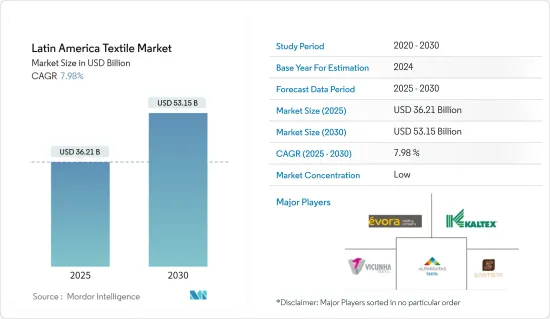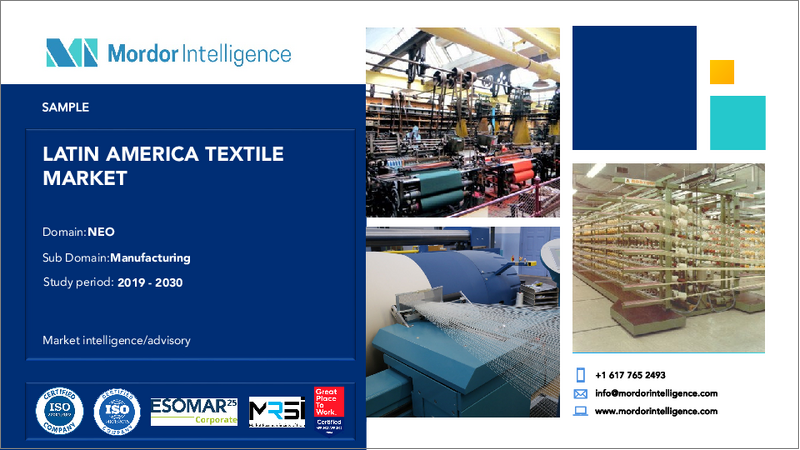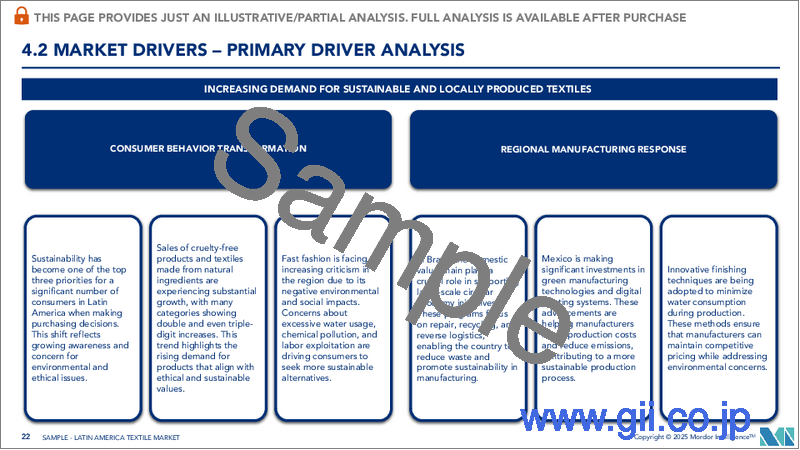|
|
市場調査レポート
商品コード
1642107
ラテンアメリカのテキスタイル:市場シェア分析、産業動向、成長予測(2025~2030年)Latin America Textile - Market Share Analysis, Industry Trends & Statistics, Growth Forecasts (2025 - 2030) |
||||||
カスタマイズ可能
適宜更新あり
|
|||||||
| ラテンアメリカのテキスタイル:市場シェア分析、産業動向、成長予測(2025~2030年) |
|
出版日: 2025年01月05日
発行: Mordor Intelligence
ページ情報: 英文 140 Pages
納期: 2~3営業日
|
全表示
- 概要
- 目次
ラテンアメリカのテキスタイルの市場規模は2025年に362億1,000万米ドルと推定され、予測期間(2025-2030年)のCAGRは7.98%で、2030年には531億5,000万米ドルに達すると予測されます。

ラテンアメリカのテキスタイル市場を特徴づけているのは、伝統的な職人技にしっかりと根ざした多様で活気のある産業と、世界のファッションとホームテキスタイル部門で存在感を高めていることです。この地域は、繊維生産に不可欠な綿やウールなどの豊富な天然資源の恩恵を受けています。ブラジル、メキシコ、コロンビアなどの主要市場は製造と輸出でリードしており、ペルーやグアテマラなどの国々は高品質な職人技によるテキスタイルで有名です。
同市場は、環境に優しい製品への世界のシフトを背景に、持続可能で倫理的に生産されたテキスタイルへの需要が高まっていることから、成長を目の当たりにしています。さらに、テキスタイル製造における技術の進歩やeコマースの台頭が、業界の拡大をさらに後押ししています。しかし、アジアの低コスト生産業者との競合や域内の景気変動といった課題にも直面しています。
ラテンアメリカのテキスタイル市場の動向
衣料産業の台頭が市場を活性化
衣料産業はラテンアメリカのテキスタイル市場の重要な促進要因であり、同地域全体の成長とイノベーションの原動力となっています。テキスタイル生産の強い伝統を持つブラジル、メキシコ、コロンビアなどの国々は、国内外市場向けのアパレル製造の最前線にあります。この地域の衣料品産業は、現地生産、持続可能、倫理的に生産された衣料品への関心の高まりなど、ファッションに対する消費者需要の増加から恩恵を受けています。また、ラテンアメリカは北米の主要消費市場に近いため、アジアの生産者に比べて納期が早く、輸送コストが低いという競争力もあります。
さらに、ファストファッションの成長とeコマースプラットフォームの拡大が、衣料品セクターにおけるテキスタイルの需要を加速させています。地元のデザイナーやブランドが認知されつつあり、業界の魅力を高めています。しかし、世界・アパレル・メーカーとの競合や、国際基準を満たすための生産設備近代化への投資の必要性など、課題も残っています。こうした障害にもかかわらず、衣料品産業は引き続き市場を前進させる極めて重要な力となっています。
綿花生産の増加が市場成長を牽引
ラテンアメリカのテキスタイル市場の成長には、綿花生産の増加が欠かせないです。ブラジル、アルゼンチン、メキシコなどの国々はこの地域の主要な綿花生産国のひとつであり、テキスタイル産業のサプライチェーンに大きく貢献しています。特にブラジルは、農業技術の進歩と持続可能な農法が生産能力を高め、世界有数の綿花輸出国として台頭してきました。
綿花生産の増加は、信頼できる高品質の原料を供給することで国内テキスタイル産業を支え、輸入への依存を減らし、国際舞台におけるラテンアメリカのテキスタイル製品の競合を強化します。このような綿花の国内入手可能量の増加は、綿織物に大きく依存する衣料品やホームテキスタイル部門の成長も支えています。
ラテンアメリカのテキスタイル産業の概要
ラテンアメリカの繊維市場は半分断されており、多くのプレーヤーが存在します。ペルー、グアテマラ、コロンビアのような伝統的で職人的な繊維生産が盛んな国で市場は強いです。こうした小規模なプレーヤーは、手工芸品や文化的に重要な織物など、ニッチ市場に注力しており、市場の多様性に寄与しています。主なプレーヤーは、Evora SA、Kaltex SA、Vicunha Textil SA、Alpargatas SAIC、Santista Argentina SAなどです。
その他の特典:
- エクセル形式の市場予測(ME)シート
- 3ヶ月間のアナリスト・サポート
目次
第1章 イントロダクション
- 調査の前提条件と市場定義
- 調査範囲
第2章 調査手法
第3章 エグゼクティブサマリー
第4章 市場の洞察と力学
- 市場概要
- 市場促進要因
- 持続可能で地元産のテキスタイル製品に対する需要の高まり
- テキスタイル職人の強い伝統
- 市場抑制要因
- 経済の不安定と為替レートの変動
- 市場機会
- 持続可能な製品に対する需要の増加
- eコマースの拡大
- バリューチェーン/サプライチェーン分析
- ポーターのファイブフォース分析
- 新規参入業者の脅威
- 買い手/消費者の交渉力
- 供給企業の交渉力
- 代替品の脅威
- 競争企業間の敵対関係の強さ
- 業界における技術革新
- COVID-19パンデミックがラテンアメリカ繊維製品市場に与える影響
第5章 市場セグメンテーション
- 用途別
- 衣料
- 産業/技術用途
- 家庭用途
- 材料別
- コットン
- ジュート
- シルク
- 合成繊維
- ウール
- プロセス別
- 織布
- 不織布
第6章 競合情勢
- 市場競争概要
- 企業プロファイル
- Evora SA
- Kaltex SA
- Vicunha Textil SA
- Coteminas SA
- Alpargatas SAIC
- Santista Argentina SA
- Santana Textiles SA
- Fabricato SA
- Pettenati SA Textile Industry
- Australtex SA*
第7章 今後の市場動向
第8章 免責事項と出版社について
The Latin America Textile Market size is estimated at USD 36.21 billion in 2025, and is expected to reach USD 53.15 billion by 2030, at a CAGR of 7.98% during the forecast period (2025-2030).

A diverse and vibrant industry with solid roots in traditional craftsmanship and a growing presence in the global fashion and home textiles sectors characterize the Latin American textiles market. The region benefits from an abundance of natural resources, including cotton and wool, which are integral to textile production. Key markets such as Brazil, Mexico, and Colombia are leading in manufacturing and export activities, while countries like Peru and Guatemala are renowned for their high-quality, artisanal textiles.
The market is witnessing growth due to increasing demand for sustainable and ethically produced textiles, driven by a global shift toward eco-friendly products. Additionally, technological advancements in textile manufacturing and a rise in e-commerce are further propelling the industry's expansion. However, the market also faces challenges, such as competition from low-cost producers in Asia and economic fluctuations within the region.
Latin America Textile Market Trends
Rise in the Clothing Industry is Fueling the Market
The clothing industry is a significant driver of the Latin American textile market, fueling growth and innovation across the region. With a strong tradition of textile production, countries like Brazil, Mexico, and Colombia are at the forefront of manufacturing apparel for domestic and international markets. The region's clothing industry is benefiting from increasing consumer demand for fashion, including a rising interest in locally made, sustainable, and ethically produced garments. Latin America's proximity to major consumer markets in North America also enhances its competitive edge, allowing for quicker turnaround times and lower transportation costs compared to Asian producers.
Additionally, the growth of fast fashion and the expansion of e-commerce platforms are accelerating the demand for textiles in the clothing sector. Local designers and brands are gaining recognition, boosting the industry's appeal. However, challenges remain, including competition from global apparel manufacturers and the need for investment in modernizing production facilities to meet international standards. Despite these obstacles, the clothing industry continues to be a pivotal force in driving the market forward.
Rising Cotton Production is Driving the Market's Growth
Increasing cotton production is crucial to the growth of the Latin American textile market. Countries including Brazil, Argentina, and Mexico are among the region's leading cotton producers, contributing significantly to the textile industry's supply chain. Brazil, in particular, has emerged as one of the world's top cotton exporters, with advancements in agricultural technology and sustainable farming practices boosting its production capacity.
The rise in cotton production supports the domestic textile industry by providing a reliable and high-quality raw material source, reducing dependency on imports, and enhancing the competitiveness of Latin American textiles on the global stage. This increase in local cotton availability also supports the growth of the clothing and home textiles sectors, which rely heavily on cotton fabrics.
Latin America Textile Industry Overview
The Latin American textiles market is semi-fragmented, with many players. The market is strong in countries like Peru, Guatemala, and Colombia, where traditional and artisanal textile production is prevalent. These smaller players focus on niche markets, such as handcrafted and culturally significant textiles, which contribute to the market's diversity. The key players include Evora SA, Kaltex SA, Vicunha Textil SA, Alpargatas SAIC, and Santista Argentina SA.
Additional Benefits:
- The market estimate (ME) sheet in Excel format
- 3 months of analyst support
TABLE OF CONTENTS
1 INTRODUCTION
- 1.1 Study Assumptions and Market Definition
- 1.2 Scope of the Study
2 RESEARCH METHODOLOGY
3 EXECUTIVE SUMMARY
4 MARKET INSIGHTS AND DYNAMICS
- 4.1 Market Overview
- 4.2 Market Drivers
- 4.2.1 Increasing Demand for Sustainable and Locally Produced Textiles
- 4.2.2 Strong Tradition of Textile Craftsmanship
- 4.3 Market Restraints
- 4.3.1 Economic Instability and Fluctuations in Currency Exchange Rates
- 4.4 Market Opportunities
- 4.4.1 Increasing Demand for Sustainable Products
- 4.4.2 Expansion of E-commerce
- 4.5 Value Chain/Supply Chain Analysis
- 4.6 Porter's Five Forces Analysis
- 4.6.1 Threat of New Entrants
- 4.6.2 Bargaining Power of Buyers/Consumers
- 4.6.3 Bargaining Power of Suppliers
- 4.6.4 Threat of Substitute Products
- 4.6.5 Intensity of Competitive Rivalry
- 4.7 Technological Innovation in the Industry
- 4.8 Impact of the COVID-19 Pandemic on the Latin America Textiles Market
5 MARKET SEGMENTATION
- 5.1 By Application
- 5.1.1 Clothing
- 5.1.2 Industrial/Technical Applications
- 5.1.3 Household Applications
- 5.2 By Material
- 5.2.1 Cotton
- 5.2.2 Jute
- 5.2.3 Silk
- 5.2.4 Synthetics
- 5.2.5 Wool
- 5.3 By Process
- 5.3.1 Woven
- 5.3.2 Non-woven
6 COMPETITIVE LANDSCAPE
- 6.1 Market Competition Overview
- 6.2 Company Profiles
- 6.2.1 Evora SA
- 6.2.2 Kaltex SA
- 6.2.3 Vicunha Textil SA
- 6.2.4 Coteminas SA
- 6.2.5 Alpargatas SAIC
- 6.2.6 Santista Argentina SA
- 6.2.7 Santana Textiles SA
- 6.2.8 Fabricato SA
- 6.2.9 Pettenati SA Textile Industry
- 6.2.10 Australtex SA*






